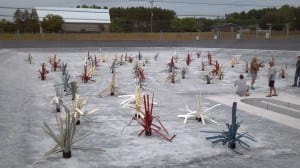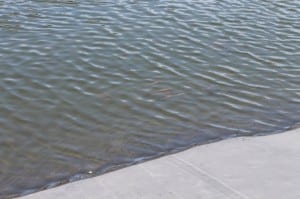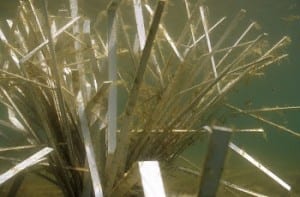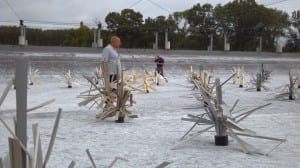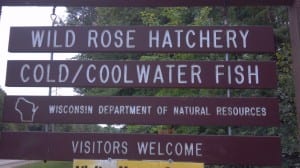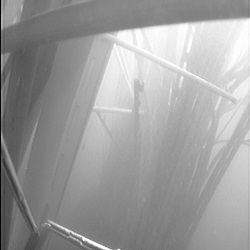Last fall at the Wild Rose State Fish Hatchery in Wild Rose, Wi, State WDNR Biologists, Supervisors and staff, eagerly awaited the start of a new pilot study, incorporating artificial habitat in rearing ponds with musky, walleye and other species. Multiple offices within the WDNR, jockeyed for position to decide just what to study first.
WDNR Biologists and staff discussed the various benefits of incorporating habitat in their Hatcheries and which species to use them on first. Musky were the first in line, with musky being the State fish. Being an ambush predator, Musky instinctually seek cover to hide and attack their prey. The grow ponds lacked anything to hide and learn to hunt around. Typically, the fish would circle the rubber lined 2 acre ponds, relating to the only physical form available, the water’s edge. Original story.
When I began discussions with Steven Fajfer, Natural Resources Operations Supervisor at Wild Rose, he explained they had been studying musky raised on pellets indoors and then switched to minnows when put in the grow ponds outside. This would be in comparison to fish that were fed minnows exclusively from start to finish. Next, they would stock pre-designated lakes with both groups of fish and track them. More habitat articles at fishiding.com
Because this study was already underway, by incorporating habitat into the above feeding parameters, this would give the Biologists even more and improved data for comparison. Although discussions and plans to use the habitat with Walleye and other species present at the Hatchery, those fish would have to wait until the Musky study was completed. Next, the hatchery had to select the best option for them in artificial habitat.
Fishiding Artificial Fish Habitat is produced using reclaimed PVC vinyl siding. Multiple pieces of durable, flat, strips of material are held together by cement, forming the base. These patented, multi-textured, bush like units, provide shade and surface area, forming a fuzz of aquatic growth when placed underwater. This natural process is nature’s pristine way of converting over abundant nutrients into periphyton, (fuzz/algae) which is then consumed by the small fish by a process called “grazing”. All fish eat this exclusively as fry.
Each unit is unfolded and bent by hand, to abstract shapes. When placed on the lake or pond bottom, they simulate something like an artificial Christmas tree, providing hiding and feeding areas. The mid-sized Safehouse model was selected as the preferred size for the staff to work with. Standing just under 4’ tall and opening up to over 7’ in diameter, each unit stays in place with the weighted base, coming in at about 15 pounds total.
The ability to wash, disinfect and re-use over and over again, made it the easy choice for the many studies the State has planned. 300 units were delivered, 75 in each of the grow ponds, awaiting delivery of the musky from the Michigan DNR.
When we left Wild Rose last fall after setting up the habitat, we could hardly wait to hear that the ponds had been filled and the Musky had been put in the grow ponds. After a number of months passed with no confirmed delivery, the anticipation turned to disappointment. The musky wouldn’t be stocked with the habitat this year. Bummer yes, but with good reason as the details unfolded.
Steven explained a great deal of the background of the State’s current and past stocking efforts with Musky. Back in the early 1900’s, the Great lakes spotted musky were common in Green Bay and the surrounding waters of Lake Michigan. Unfortunately, poor water quality and over fishing wiped them out. Starting in 1989, Wisconsin received eggs from the Michigan DNR and began restocking them in Green Bay. When those fish became mature and attempted to spawn naturally, they became the source of eggs for the stocking program, since there was very limited natural reproduction. With the outbreak of VHS in 2007, that was no longer an option.
With the local fish not viable to use for brood stock anymore per VHS, that wasn’t the only problem with local stock as the genetic diversity was lacking. About 2007, the State began looking for other outlets to acquire the Great Lake Strain. For a few years, WDNR worked with Ontario, purchasing fingerlings from Georgian Bay stock, which had been raised on pellets. This worked ok, with most fish being stocked directly into Wisconsin inland lakes and a few grown at the Westford Hatchery to about 12” and then stocked. The biggest problem was the red tape getting them across the border each time, resulting in lengthy delays and increased costs.
Back in 1989, the WDNR began working with the Michigan DNR Fisheries department, stocking Great Lakes Musky in places like the Indian River, Burt and Mullet lakes. to name just a few. Michigan also has a top notch program and cool water facility. Easy to transport, healthy and close to home, the two States work well together on each other’s experience and knowledge. Michigan has a wonderful and robust fishery, with plans to improve the State’s fishing opportunities even more. Recently, $1,000,000 in Grant money has been made available for habitat improvement and installation projects.
The Musky that are to be brought in to Wild Rose for the habitat study are coming from Michigan……at some point. About a week before the fish were to be delivered they were tested one more time by the Michigan DNR staff. There was a problem. The biologists discovered Piscirickettsia-like organisms, or something called P.L.O disease in the Musky.
The presence and importance of Piscirickettsia-like bacteria in mammals have been long recognized, but only in recent years could they be identified and characterized in aquatic animals. For this reason, it was not until the late 1980s that Rickettsia agents were linked with major diseases in fish, and subsequently attributed as the cause of substantial economic losses due to disease-related mortality in the 1990s. Piscirickettsiosis and piscirickettsiosis-like diseases have affected aquaculture productivity, profitability, species compatibility with commercial rearing, and fish transport.
Musky with the disease were first discovered in Lake St. Clair in the early 2000’s. It can appear as red spots or blotches on the fish. The WDNR asked them to hold onto the fish for further testing, which showed no definitive results of where or how they were infected. Although the fish appeared healthy, robust and happy, the Wisconsin officials regrettably had to decline the importation. A sincere feeling of disappointment spread through the various department offices, as the realization of waiting another year to begin the study solidified.
“The risk is simply too high to utilize fish with ANY known issues or problems.” That is the standpoint the WDNR had to take. “The investment in time and money to study diet and habitat with any potentially skewed fish stock is not an option.” It’s not known what the Michigan Hatchery did or will do with the infected fish, but a new, fresh batch of Great Lakes Strain Spotted Musky are already growing fat, planning to come to Wisconsin this fall of 2014.
The Wisconsin DNR Fisheries Department and their own state of the art Wild Rose State Fish Hatchery, will continue to draw attention. Known as one of the finest run Hatchery programs in the Nation, all eyes are on the leaders, the ones to watch.
It’s tough decisions like these, that ensures that anglers all across the state will continue to enjoy some of the World’s finest freshwater fishing. Plans to utilize the habitat are taking place with walleye, while the musky mature for delivery. “We have plenty of fish that we are eager to study within the habitat. We just wanted to start first with our well known and much loved Musky.”
Patience and adjustment to ever changing issues in the aquatic realm is a stark reality today. Learning from past experience and pushing for new ways to grow better, stronger and more sustainable fisheries, the Musky habitat study will happen. This fall, Wisconsin’s plans to grow smarter, stronger, “super” muskies will begin.
